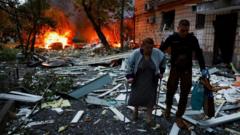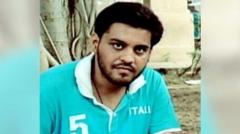The Air India disaster has ignited concerns regarding aircraft safety and response measures as at least one survivor emerges from the wreckage, while Indian authorities continue to search for answers and support victims’ families.
**Tragedy Strikes: Air India Flight Crashes in Ahmedabad, Over 200 Lives Lost**

**Tragedy Strikes: Air India Flight Crashes in Ahmedabad, Over 200 Lives Lost**
A devastating plane crash in Ahmedabad claims over 200 lives as an Air India Boeing 787 goes down shortly after takeoff.
Amid the smoke and debris of Ahmedabad, tragedy unfolded on June 12, 2025, when an Air India Boeing 787-8 Dreamliner crashed moments after taking off, resulting in over 200 fatalities out of 242 passengers and crew members aboard. The plane was en route to London Gatwick Airport when it went down shortly after takeoff, colliding with the B.J. Medical College's dining facility in a devastating disaster.
Rescue operations escalated as emergency crews worked through layers of debris, hoping to locate potential survivors among the wreckage. As night fell, images from the site depicted rescue workers sifting through charred remnants, while the locally produced videos conveyed the catastrophic scene of a large explosion and smoke billowing from the crash site.
Ahmedabad's police commissioner reported 204 fatalities with at least one individual identified as a survivor, amidst efforts from medical responders to treat injured individuals. The survivor, potentially identified as British national Viswashkumar Ramesh, was reported to have sustained extensive injuries but was no longer considered in danger.
The aircraft's descent was captured on CCTV footage, revealing an alarming lack of altitude shortly after takeoff, raising questions surrounding possible mechanical failure, pilot error, or environmental factors influencing the crash. Investigators from multiple countries, including the U.S. and the U.K., are en route to assist in determining the causes of the tragic event.
As family members anxiously awaited news of their loved ones, Air India CEO Campbell Wilson expressed deep condolences and confirmed relief operations for families of the passengers. Prime Minister Narendra Modi described the disaster as “heartbreaking” and extended his sympathies to those affected.
The incident stands as the deadliest aviation disaster in India since 1996, raising significant concerns about transport safety protocols and vehicle integrity, particularly involving the Boeing 787 model, which had previously avoided fatal accidents throughout its operational history.
While a full investigation into the crash could prolong for years, the immediate recovery efforts and investigation into the events leading up to this tragedy continue to unfold, leaving a community devastated and searching for answers.
Rescue operations escalated as emergency crews worked through layers of debris, hoping to locate potential survivors among the wreckage. As night fell, images from the site depicted rescue workers sifting through charred remnants, while the locally produced videos conveyed the catastrophic scene of a large explosion and smoke billowing from the crash site.
Ahmedabad's police commissioner reported 204 fatalities with at least one individual identified as a survivor, amidst efforts from medical responders to treat injured individuals. The survivor, potentially identified as British national Viswashkumar Ramesh, was reported to have sustained extensive injuries but was no longer considered in danger.
The aircraft's descent was captured on CCTV footage, revealing an alarming lack of altitude shortly after takeoff, raising questions surrounding possible mechanical failure, pilot error, or environmental factors influencing the crash. Investigators from multiple countries, including the U.S. and the U.K., are en route to assist in determining the causes of the tragic event.
As family members anxiously awaited news of their loved ones, Air India CEO Campbell Wilson expressed deep condolences and confirmed relief operations for families of the passengers. Prime Minister Narendra Modi described the disaster as “heartbreaking” and extended his sympathies to those affected.
The incident stands as the deadliest aviation disaster in India since 1996, raising significant concerns about transport safety protocols and vehicle integrity, particularly involving the Boeing 787 model, which had previously avoided fatal accidents throughout its operational history.
While a full investigation into the crash could prolong for years, the immediate recovery efforts and investigation into the events leading up to this tragedy continue to unfold, leaving a community devastated and searching for answers.




















